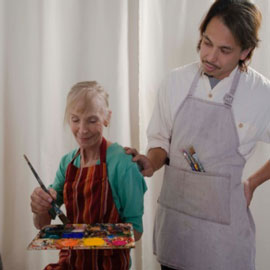Unlocking your Inner Artist
H ow art therapy may benefit patients of weight loss surgery
ow art therapy may benefit patients of weight loss surgery
Art has been a part of every major culture since the dawn of man, used as a means of expressing our deepest, most inexpressible feelings. From primitive cave paintings to elegant Renaissance perfection and the contemporary works of today, art has provided us with a way to convey that which cannot be put into words by pouring ourselves into paints, pastels, canvas, paper or sculpture.
Though you may not be Pablo Picasso, or the slightest bit artistically inclined, creative expression can be a therapeutic practice for people from all walks of life. Because losing weight with JSAPA Weight Loss Surgery can be a stressful prospect, your weight loss surgeon may recommend one of many different methods of emotional support or therapy. Traditional forms of support groups and therapy are hugely beneficial for many patients, but learning how to creatively express yourself with art therapy is another unique way to help you heal from physical and emotional pain, even if you haven’t touched a paintbrush since grade school.
What is Art Therapy?
Art therapy is based on the idea that the creative process can enhance the emotional, physical and mental well-being of all individuals. According to the American Art Therapy Association (AATA), the act of artistic self-expression can help with:
- Development of interpersonal skills
- Behavior management
- Increased self-esteem
- Stress reduction
Art therapy didn’t emerge as a recognized practice until the 1940s, when psychiatrists began looking at patients’ artwork for insights into mental illness. Educators started to pay closer attention to the art of children, searching for ways that it reflected their emotional and mental development. Before long, hospitals and rehab centers began regularly incorporating art therapy into their programs, recognizing its effectiveness in aiding patient recovery.
What Do Art Therapists Do?
Art therapists are credentialed professionals who dedicate years of study to understanding how to harness the healing power of art. They study both traditional therapy and art, using artistic methods in assessment, treatment and research. They can be found in schools, hospitals, rehab centers, nursing homes, independent medical practices and more, developing individualized programs for their patients that help them solve problems, develop new skills and resolve emotional conflicts through catharsis.
The approach of art therapy can vary widely. Sometimes, art therapists will take an unstructured approach that allows patients to use materials and media in whatever way they see fit, allowing unconscious feelings to be freely expressed. Conversely, an art therapist may ask a patient to draw a picture of something specific, like his or her family, to better understand complex social dynamics that may contribute to unhealthy patterns of behavior. Art therapy can even be used in a group setting, with multiple patients working together to create a collage or mural that stimulates discussion.
Art Therapy after Weight Loss Surgery
Some art therapists find the practice particularly useful in those with eating disorders, which can often stem from unresolved emotional issues like depression, helplessness, loss or anger. By unlocking those buried feelings with art therapy, we can address, cope with and move on from our struggles.
Some of the theory behind art therapy relates to the idea that creativity and healing come from the same source deep within us. Art therapy is not just a glorified arts and crafts session—it is a multisensory way to teach people how to purposefully use tangible objects to communicate their intangible pain with the outside world.
If you’re looking for a way to reconnect with your inner artist and your innermost emotions after weight loss surgery, art therapy may be a prudent choice.
